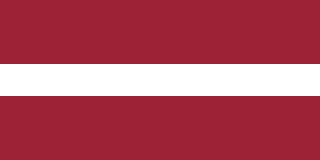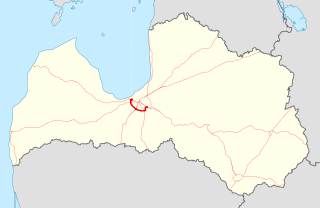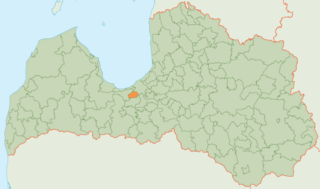
Latvia, officially the Republic of Latvia, is a country in the Baltic region of Northern Europe. It is one of the Baltic states; and is bordered by Estonia to the north, Lithuania to the south, Russia to the east, Belarus to the southeast, and shares a maritime border with Sweden to the west. Latvia covers an area of 64,589 km2 (24,938 sq mi), with a population of 1.9 million. The country has a temperate seasonal climate. Its capital and largest city is Riga. Latvians belong to the ethno-linguistic group of the Balts; and speak Latvian, one of the only two surviving Baltic languages. Russians are the most prominent minority in the country, at almost a quarter of the population.

Foreign relations of Latvia are the primary responsibility of the Ministry of Foreign Affairs. Today's Republic of Latvia regards itself as a continuation of the 1918–1940 republic. After the declaration on the restoration of its full independence on August 21, 1991, Latvia became a member of the United Nations on September 17, 1991, and is a signatory to a number of UN organizations and other international agreements. Latvia welcomes further cooperation and integration with NATO, European Union, OECD and other Western organizations. It also seeks more active participation in UN peacekeeping efforts worldwide.

Riga is the capital of Latvia and is home to 614,618 inhabitants (2021), which is a third of Latvia's population. Being significantly larger than other cities of Latvia, Riga is the country's primate city. It is also the largest city in the three Baltic states and is home to one tenth of the three Baltic states' combined population. The city lies on the Gulf of Riga at the mouth of the Daugava river where it meets the Baltic Sea. Riga's territory covers 307.17 km2 (118.60 sq mi) and lies 1–10 m (3.3–32.8 ft) above sea level, on a flat and sandy plain.

Jūrmala is a city in Latvia, about 25 kilometres west of Riga. Jūrmala is a resort town stretching 32 km and sandwiched between the Gulf of Riga and the Lielupe River. It has a 33 km stretch of white-sand beach, and a population of 49,325 in 2019, making it the fifth-largest city in Latvia.

Riga State Gymnasium No.1, the oldest school in the Baltic states, offers secondary education in Riga, the capital of Latvia.
Tet is a Latvian internet service provider, telecommunications, technology and entertainment company. Since 2017, it also is an electricity service provider.

Vitālijs Astafjevs is a Latvian former professional football midfielder, and former assistant manager of the Latvia national team.

Daugava National Stadium is a multifunctional stadium in Riga, Latvia, which was first opened in 1927. It holds football and athletics competitions. Since 1992 the Daugava Stadium has been designated as a sports facility of national importance and is owned by the Government of Latvia.

Purvciems is a neighbourhood in the Vidzeme Suburb of Riga, Latvia. Its name literally translates as "marsh village". It is located on the east bank of the River Daugava, to the east of the City Centre and is defined roughly as the area between A. Deglava Iela and Ieriķu Iela. The area is characterised by apartment blocks from the late Soviet and the first years after the restoration of Latvian independence (1980s–1990s), though there is also some detached housing. The district is Latvian and Russian-speaking.

Čiekurkalns is neighbourhood of Northern District in Riga, the capital of Latvia. It is located on the southwestern shore of Lake Ķīšezers.

The Riga Marathon is an annual road marathon held in Riga, Latvia, since 1991. It is a member of AIMS and is categorized as a Gold Label Road Race by World Athletics. The marathon starts and finishes near Riga Castle, and runs through Old Riga as well as across the Daugava River. As of 2019, the marathon winner may receive up to 15,000 EUR in prize money, plus a bonus if the distance record is also broken.

The A10 is a national road in Latvia connecting Riga to Ventspils. The road is part of the European route E22.

The A5 is a national road in Latvia which is part beltway around Riga, connecting Salaspils to Babīte. The road is also known as Riga bypass. The road is part of European route E67, European route E77 and Latvian TEN-T road network. The length of A5 is 41 kilometer. Currently A5 has 1x1 lanes until interchange with A9 then it turns to 2x2 all the way until Babīte. Most of the traffic on A5 is made up by trucks. A5 crosses river Daugava on Riga HES, and the A5 part on the HES has been reconstructed in 2010/2011. Another part of A5 between A8 and A9 was reconstructed in 2011. There are plans to build a new bridge over Daugava opposite to the end of A4, in further future. Current speed limit is 90 km/h. The average AADT of A5 in 2016 was 12 482 cars per day.

The A6 is a national road in Latvia, connecting Riga to the Belarusian border at Pāternieki. It bypasses Daugavpils in its north and passes through Krāslava and is also known as the Daugavpils Highway in Latvia.

The A7 is a national road in Latvia connecting Riga to the Lithuanian border (Grenctāle), through Bauska. The road is also known in Latvia as the Bauska Highway. The A7 is part of European route E67 and the European TEN-T road network. The road becomes the Lithuanian A10 at the border. The length of the A7 in Latvian territory is 86 kilometers. Currently the A7 has 2x2 lanes only within the territory of Riga, other parts have 1x2 lanes. The current speed limit is 90 km/h except within municipalities. In period of 2005 - 2006, the A7 was reconstructed from the 25th until the 43rd kilometer and from the 67th until the 85th kilometer. A 2 kilometer stretch of the road was reconstructed in Iecava, and reconstruction of another 15 kilometer long stretch was finished in 2012. Construction of the Ķekava bypass is planned to begin in 2017. The bypass will be built to expressway or motorway standards. The average traffic (AADT) on the A7 during 2016 was 14,599 cars per day.

The A8 is a national road in Latvia connecting Riga to Lithuanian border (Meitene), through Jelgava, also known as Jelgava highway in Latvia. The road is part of European route E77 and Latvian TEN-T road network. After the border, the road turns into Lithuanian A12. The length of A8 in Latvian territory is 76 kilometers. Currently A8 has 2x2 lanes until Jelgava bypass, other parts have 1x1 or 2x1 lanes. The current speed limit is 100 km/h. Plans to reconstruct A8 in to an motorway have been many. First, in 2004, then in 2010, but they never started due to financial reasons. In the recent years A8 has been reconstructed in many stretches. The average AADT on A8 in 2015 was 13,711 cars per day.

Latvijas Radio is Latvia's national public-service radio broadcasting network. It began broadcasting on 1 November 1925, and has its headquarters in the Latvian capital, Riga. Latvijas Radio broadcasts six different channels in the FM band as well as via the internet: Latvijas Radio 1, Latvijas Radio 2, Latvijas Radio 3 – Klasika, Latvijas Radio 4 – Doma laukums, Latvijas Radio 5 – Pieci.lv, and Latvijas Radio 6 – Radio NABA.

Ropaži Municipality is a municipality in Vidzeme, Latvia. The municipality was formed in 2005 with the reorganization of Ropaži parish. The administrative centre is Ropaži. The population in 2020 was 6,835.

Engure Municipality is a former Latvian municipality situated partly in the region of Courland and partly in Vidzeme. It bordered Mērsrags municipality, Tukums municipality, Jūrmala and the Gulf of Riga. The municipality was formed in 2009 by merging Engure parish, Smārde parish and Lapmežciems parish, with the administrative centre being Smārde. The population in 2020 was 7,124.

Mārupe Municipality is a municipality in Latvia. The municipality was formed in 2009 by reorganization of Mārupe Parish the administrative centre being Mārupe.





















